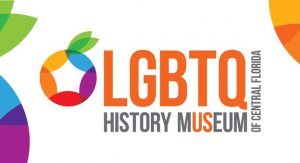
In honor of Come Out With Pride on October 10, Martha Brenckle writes about The LGBTQ History Museum of Central Florida as they celebrate their fifteenth anniversary on the same day.
The LGBTQ History Museum of Central Florida serves to preserve and present the history of our community and its rich heritage. Founded in 2005 as the “GLBT History Project” by a small group of volunteers, the archive provides a look into the lives and experiences of LGBTQ people throughout Central Florida. If you browse through our digital museum (http://www.floridalgbtqmuseum.org/) you will find Central Florida’s LGBTQ history displayed in a wide range of media, including photography, news clippings, video oral histories, and personal memorabilia. The importance of highlighting the history of the LGBTQ political movements and rights cannot be more strongly expressed as people around the world—and in our own neighborhoods—face discrimination, inequality and violence because of who they are, who they love or how they look. The museum wishes to celebrate sexual and gender identities as integral parts of Central Florida History.
Fifteen years ago on October 10th, the museum held its first exhibit at that year’s Pride Parade and celebration. The LGBT History Museum of Central Florida began in 2005 as the GLBT History Project when a small group came together to plan a history exhibit in the Orange County Regional History Center as part of the first Come Out With Pride (COWP) celebration in October 2006. Dr. Ken Kazmerski, past President of the GLBT History Museum and retired UCF Professor, and several others were approached by the Metropolitan Business Association of Orlando’s president, Debbie Simmons, to create a one-day GLBT exhibit at the Regional History Center. Originally, the project had no funding and members of the project used their own memorabilia to create displays.
An article by Billy Manes, published in the Orlando Weekly, October 12, 2006 illustrates the early days of the museum when collecting and archiving the “stuff” from people’s spare rooms and attic spaces was in its infancy: “‘There’s a distinct absence of “real history” available: a poster from a Lily Tomlin AIDS benefit or a picture of four guys mugging in front of the Parliament House here, copies of various newsletters there. And most questions about actual dates are met with a vague, “‘I don’t know, I think it was around ’87 or maybe ’91.’”
Although Debbie Simmons chaired most of the organization’s early meetings, by 2006 Dr. Ken Kazmerski became chair and began a new focus on professionalization. The early exhibits showed a preponderance of bar memorabilia. At a time when LGBTQ people were afraid to share last names or have a colleague find out they were gay, bars were a place to meet. The board has slowly expanded this focus as newsletters, posters, oral histories and other documents are donated to the museum. Currently, the board is making a concentrated effort to collect the history of POC in the LGBTQ community, something overlooked for far too long.
In 2012, the museum was established as non-profit corporation. A new virtual museum was constructed in 2018 and collaborations with RICHES, CHDR, and the GLBT Center on Mills were made. The museum board now includes CAH faculty and History and Texts & Technology graduate students. Drs. Rose Beiler, Martha Brenckle, Connie Lester, and Sara Raffel serve on the board, graduate students David Matteson and Alexis Rodriguez
While public school curriculums expanded to include the histories and contributions of previously overlooked minority groups, LGBTQ history is neither taught in school nor (usually) taught as part of family histories. Learning an LGBTQ inclusive history can help us better understand our world and our differences, which leads to acceptance and safer, more inclusive spaces for all.
The mission of the LGBTQ History Museum of Central Florida, Inc. is to collect, preserve and exhibit the history of the Lesbian, Gay, Bisexual and Transgender community in Central Florida. We are dedicated to collecting and preserving memorabilia, providing a documentary record for research and displaying with pride our community’s social and historical contributions, so our legacy will always be remembered.